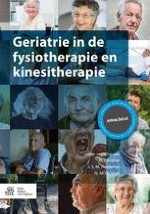Samenvatting
Om tijdens alledaagse bewegingen onze balans te bewaren en niet te vallen, moet de positie van het lichaamszwaartepunt ten opzichte van het steunvlak worden gecontroleerd. Een goede balanscontrole vergt een adequaat samenspel van de sensorische subsystemen, de bijbehorende afferente zenuwen, delen van het brein en het motorische systeem. Fysiologische veroudering van deze systemen beperkt het vermogen om balans te controleren tijdens staan en lopen. Om dit vermogen tot balanscontrole bij ouderen te testen kan gebruikgemaakt worden van vragenlijsten, functionele testen van houding en beweging of geavanceerde methoden om de kwaliteit van subsystemen te bepalen en van het vermogen om een verstoorde balans te herstellen. Bij een verstoorde balans is verbetering mogelijk door training; de meest effectieve vorm van training voor balansverbetering en valreductie is functionele balanstraining, waarbij combinatie met krachttraining, het uitdagen van specifieke sensorische processen en het gebruik van cognitieve dubbeltaken het meest zinvol lijkt.
